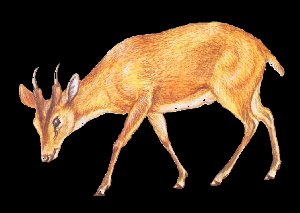
|

|
|
|
Muntiacus6 species| Black Muntjac or Hairy-fronted Muntjac || Bornean Yellow muntjac || Fea's Muntjac || Gongshan muntjac || Indian Muntjac || Reeve's muntjac or Barking Deer |
| Muntiacus crinifrons || Muntiacus atherodes || Muntiacus feae || Muntiacus gongshanensis || Muntiacus muntjak || Muntiacus reevesi | | Commun name : Black Muntjac or Hairy-fronted Muntjac
Latin name : Muntiacus crinifrons (Sclater 1885)
Localisation : East China.
Habitat : forest
Size : 1 m length, 50 cm high
| |
| Commun name : Bornean Yellow muntjac
Latin name : Muntiacus atherodes (Groves & Grubb 1982)
Localisation : Indonesian island of Borneo.
Habitat : Moist forest
Size : 1 m lenght, 50 cm high, 13.5-17.7 kg
The overall coat is a yellowish orange. Diurnal species | |
| Commun name : Fea's Muntjac
Latin name : Muntiacus feae (Thomas & Doria 1889)
Localisation : Laos, Tenasserim, Thailand, Burma.
Habitat : forest
Size : 1 m de length, 50 cm high
included in old species rooseveltorum | |
| Commun name : Gongshan muntjac
Latin name : Muntiacus gongshanensis (Ma 1990)
Localisation : North burma, sud-essouth-east Tibet.
Habitat : forest
Size : 1 m length, 50 cm high
| |
 | Commun name : Indian Muntjac
Latin name : Muntiacus muntjak (Zimmermann 1780)
Localisation : Sri Lanka, India, north-eastern Pakistan, Nepal, Bhutan, Bangladesh, south of China, Malaysia, Sumatra, Borneo, Java, Bali, indonesian islands.
Habitat : forest
Size : 1 m length, 50 cm high
It carries litthe antler (15 cm) with only one branch and related to a broad and hairy pivot. At the time of the rut it pushes small cries close to a barking. Forester, recluse and diurnal. On the slopes of the Himalayas, they go up until more 2000m of altitude . To see pictures, click here | 15 sub-species- Muntiacus muntjak annamensis : _______, Indochina (Kloss 1928) .
- Muntiacus muntjak aureus : Indian Muntjac (2), Peninsular India (H. Smith 1826) .
- Muntiacus muntjak bancanus : _______, Billiton and Banka Island (Lyon 1907) .
- Muntiacus muntjak curvostylis : _______, Thailand (Gray 1872) .
- Muntiacus muntjak grandicornis : Burmese Muntjac, Burma (Lydekker 1904) .
- Muntiacus muntjak malabaricus : Indian Muntjac (3), South India and Ceylon (Lydekker 1915) .
- Muntiacus muntjak montanus : Mountain Muntjac, Sumatra (Robinson & Kloss 1918) .
- Muntiacus muntjak muntjak : Javan Muntjac, Java and south Sumatra (Zimmermann 1780) .
- Muntiacus muntjak nainggolani : _______, Bali and Lombok Islands (Sody 1932) .
- Muntiacus muntjak nigripes : Black-footed or Black-legged Muntjac, Vietnam and Hainan Island (G.M. Allen 1930) .
- Muntiacus muntjak peninsulae : _______, malaya (Lydekker 1915) .
- Muntiacus muntjak pleicharicus : _______, South Borneo (Kohlbrugbe 1896) .
- Muntiacus muntjak robinsoni : _______, Bintan Island and Linga Archipelago (Lydekker 1915) .
- Muntiacus muntjak rubidus : _______, North Borneo (Lyon 1911) .
- Muntiacus muntjak vaginalis : Indian Muntjac (1), Burma to southwest China (Boddaert 1875) .
|
 | Commun name : Reeve's muntjac or Barking Deer
Latin name : Muntiacus reevesi (Ogilby 1839)
Localisation : Southern China, Taiwan, introduced in Great-Britain and France.
Habitat : forests
Size : 90 cm length, 40 cm high, 11-16 kg
The short, soft coat is a reddish brown in colour, with the undersides, including the lower legs and the ventral surface of the neck and chin, fading to creamy white. The forehead and nose are black, while the surrounding face is generally a pale tan. . When alarmed or in the presence of potential danger, muntjacs make a sharp barking sound, which is surprisingly loud and gives them their alternate name "barking deer". To see pictures, click here | 2 sub-species- Muntiacus reevesi micrurus : _______, Formosa (Sclater 1875) .
- Muntiacus reevesi reevesi : _______, Southeastern China (Ogilby 1839) .
|
|

|

|
|